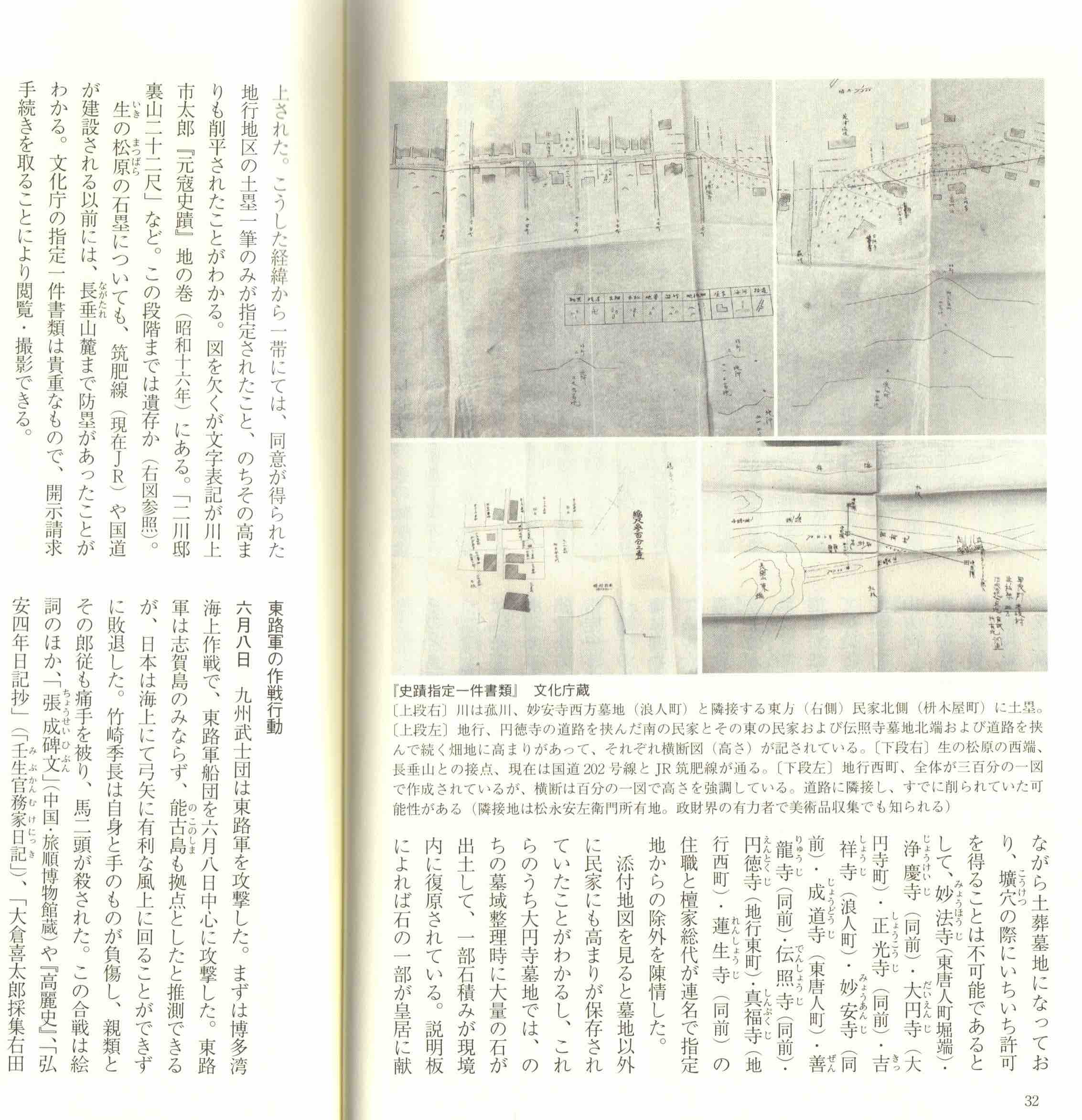
*60ページ上13行〜17行
T字のマークが不鮮明〜止まっていた。
→
T字のマークが入角にあった。のちの写本である金城録・町場請取絵図(『巨大城郭名古屋城』12頁)では弓矢櫓が建つことになる石垣の下部に「五間」と記している。
*62ページ下4行
搬入路である。
→
搬入路である(『史料が語る 名古屋城石垣普請の現場』65頁、原史彦コラム写真)。
*28・149ページ右5行
みで、の1点である。 → み、1点である。
*52ページ上4行
小橋を元和八年架橋とする記事もあって、
→
小橋について元和八年架橋とする記事もあって(右記留帳)、
*76ページ上後ろ4〜5行
『紀要』3
本紀要2号−68頁
→
『(本)紀要』3号−二三頁
『(本)紀要』2号−六八頁
*84ぺージ上8行
事跡録 → 事蹟録
*84頁下7頁
橋脚は描かれる → 橋脚は描かれる(『(本)紀要』本号五五頁図版)
・教科書地図、まちがいさがし7
・石築地(元寇防塁)分布地図
『歴史研究』720・2024年6月号、24〜39頁
図をクリックすると拡大できます
古文書の第一のグループはキリシタンを取り締まる側であった五島藩が作成した 五島の中の中通島の転びキリシタンのリストである(西南学院大学博物館所蔵 )。彼ら彼女らは転向して慶長十九年、つまり1614年に仏教徒になった。彼 ら彼女らを受け入れ、担当になったのは仏教寺院の檀那寺(依拠した仏教寺院) である。その寺は藩主の菩提寺である福江島大円寺・だいえんじであった。藩主 五島玄雅(まさはる)はキリシタン大名であったから、キリシタン時代には菩提 寺大円寺は教会であったと想定する。転びキリシタンはキリシタン時代の縁故を 頼って、新たな宗教的な支えを大円寺に求めた。
古文書の第2のグループはスペイン・マドリッドに所在する二つのイエズス会文 書館に存在する。イエズス会日本管区長Courosが取り集めた文書である。転向し た元キリシタンのリストが残る五島中通島にて、同じ村の幹部たちは、三年後の 元和三年、1617に、「自分たちは以後もキリシタンであり続ける」と誓約し た。イエズス会日本管区長Courosはそれをヨーロッパにまで送り届けた。島のキ リシタンたちは転ばなかった。それで彼らは転向してしまったキリシタンリスト には載せられていない。,
当時キリシタンであることを明らかにした上で、そのまま村で生き続けること は難しかった。Couros文書に署名した村のいくつかが、天草島原のキリシタン一 揆、原城の戦いに参加して籠城、大半が死んでしまった。キリシタンであったら 、その地域では生きられなかった。中通島でも、キリシタン村のうち村自体が消 えたものもある(例えば「かのこ」)。のち九州本土からの移民によって開拓が 実行された地域でのみ、かくれキリシタンの信仰が継続された。
Couros文書に署名した村では長崎の浦上、天草の﨑津、今富、大江がそのままか くれキリシタン村にて信仰を継続できた村である。その道はけっして安易ではな かった。﨑津は世界遺産登録されており、調査も進んでいるが、奈留島、中通島 などの村についてはさらなる総合調査が期待される。
Hattori Hideo, Chairman of Nagasaki World Heritage Academic Committee/ Emeritus Professor of Kyushu University
The World Heritage Site "Hidden Christian Sites in the Nagasaki Region" consists of the villages and remains of the Japanese Christianity, which withstood more than 250 years of persecution and continued to live as a secret religion. Its history and story are unprecedented in world history, and it has been inscribed on the World Heritage Site due to its rarity. In this study, I will reconstruct the aspects of that era in detail based on historical materials. There are ancient documents that describe the oppression situation at that time.
The first group of ancient documents is a list of fallen Christians(転びキリシタン ・korobi-kirisitan) on Nakadori Island(中通島) in the Goto(五島) Islands, created by the Goto Clan, which was responsible for cracking down on Christians (owned by the Seinan Gakuin University Museum). They converted and became Buddhists in 1614 (the 19th year of Keicho). Buddhist temples called “danna-dera” (檀那寺) accepted them and took charge of them. For these individuals, the danna-dera was Daien-ji(大円寺) Temple on the Fukue Island, the family temple of the feudal lord. Since the lord of the domain, Goto Masaharu(五島玄雅), was a Christian daimyo, the author speculates that the family temple, Daien-ji, was a church during the time when there were Christians.The Christians turned to Daien-ji Temple for new religious support, relying on connections from the Christian era. The second group of ancient documents resides in two Jesuit archives located in Madrid, Spain(AESI-A and RAH) . These documents were compiled by priest Matheus de Couros, a Jesuit regional director in Japan. In 1617 (the 3rd year of Genna), the leaders from the same village on the Nakadori Island pledged that they would continue to be Christians, and Couros sent the written pledge to Europe. The Christians on the island did not renounce their faith, and therefore, they are not included in the list of converted Christians.
At that time, it was difficult to continue living in the village after revealing that one was a Christian. Some of the villages that signed the Couros document participated in the Amakusa Shimabara Christian uprising and in the Battle of Hara Castle(原 城), where they were besieged and most died. Christians could not survive in that area. Even on Nakadori Island, some Christian villages, such as Kanoko(かのこ), disappeared over time. In the case of the Goto Islands, no Christians would have been able to even hide. The Hidden Christian faith continued only in areas that were later settled by immigrants from mainland Kyushu.
Among the villages that signed the Couros document, Urakami in Nagasaki, Sakitsu(﨑津), Imatomi and Oe in Amakusa were able to continue their faith as hidden Christian villages, although the path was by no means easy. Sakitsu is registered as part of a World Heritage Site and well surveyed, however, some other villages, like Naru and Nakadori, are still awaiting further Comprehensive surveys.